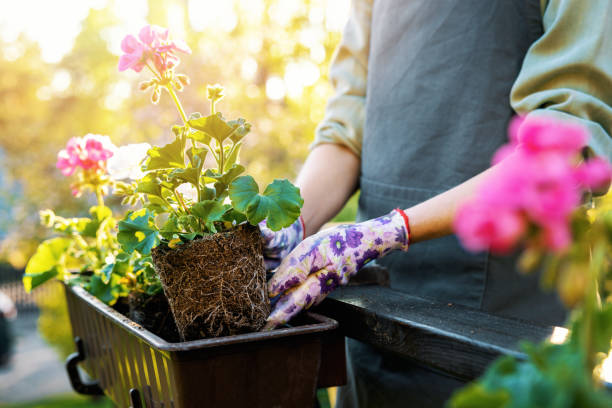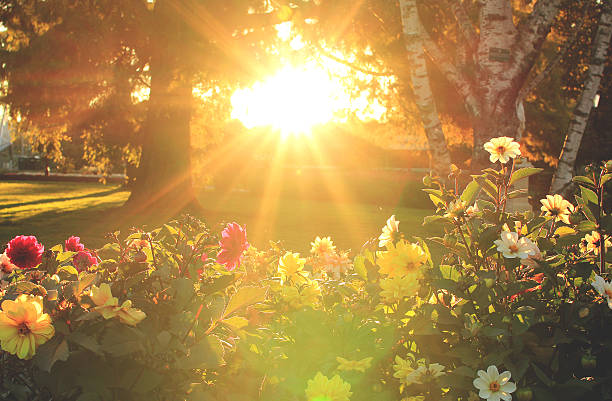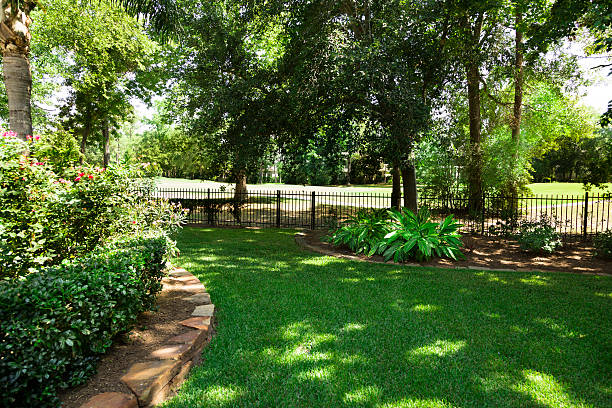When cultivating any kind of garden plan, one of the most crucial factors to consider is the amount of light the garden is exposed to. Ornamental and vegetable gardens are significantly affected by the amount of light in the garden. In this guide we share the facts, tips, and tricks on effective garden sun exposure.
Planning Your Garden For Maximum Sun Exposure

Garden sun exposure is one of the most important factors that influence the success and growth of your garden. When we speak about sun exposure, we’re mainly referring to the amount or level of sunlight that several areas of your garden receive throughout the day and how to maximize sunlight in the garden.
Sunlight is most vital for photosynthesis, which is a major source of food and energy. Understanding the patterns of sun exposure in your garden can empower you to make informed choices and curate an optimal garden layout; where to plant your crops and flowers, making sure they receive the light they need to thrive.
Why Sun Exposure Matters For Your Garden

Want to know the importance of sunlight for plants? or why should you care about sun exposure? Well, plants are somewhat like solar panels, converting the sun’s rays into energy. Insufficient sunlight will lead to your plants struggling to grow or even death. Different plants and gardens have varying garden sunlight requirements, ranging from full sunlight to partial shade.
For instance, sunflowers and tomatoes thrive beautifully in full sunlight, while hostas and ferns prefer a more cool shade. Plant growth and sunlight are highly dependent on each other and insufficient light can lead to weak steams, low yields, and an increased vulnerability to pests and diseases.
How To Assess Your Garden’s Sunlight Patterns

For successful planning for sun exposure, you ought to take a closer look at your garden’s sun patterns using sun mapping techniques. This process can be referred to as garden sunlight assessment.
Begin by observing how the light changes from morning to evening. Track the movement of the sun with sun tracking methods such as; creating a sun map and observing the shadow patterns created by the sun.
You might want to spend some time jotting down notes from observations of the areas that get full sun versus areas shaded by trees or structures. Try using a sun chart or mark spots with chalk or flags to visualize sunlight paths. This assessment is important because most homeowners overlook areas that could be great spots for planting.
Selecting The Right Plants For Sunny Areas

When planning your garden, it might seem easier to go to your local nursery and just pick up whatever looks good. However, if you’re interested in a more organized garden design such as; best plants for full sun and a better shot at happy and healthy sun-loving garden plants, including some strategy and intention when choosing your plants will go a long way.
Once you have marked out areas with sun exposure, the next move is selecting plants for sunlight for optimal use of the abundant light. Picture sun-loving plants that thrive in heat such as; peppers, basils, and zinnias that soak up all the sun rays and flourish. Try to group plants with similar light and moisture needs to optimize your garden’s layout. It not only helps them to grow healthier but also makes maintenance easier.
Designing Your Garden Layout To Maximize Sun Exposure

Creating a functional garden layout design involves more than just planting some plants in the ground wherever looks suitable. Think about the horizontal and vertical space of your garden area. During plant placement for sunlight, consider arranging taller plants and placing them at the back or sides if you’re working with a raised bed. This helps to ensure that they don’t cast shade on the shorter plants.
You have to think of a way of optimizing garden space. Rotate your plants each season to prevent soil depletion and recurring diseases. A wider space allows for sufficient air circulation, which enhances sun exposure and plant circulation, which enhances sun exposure and plant health. Do not be scared to plan it all out on paper first. Plan your layout with an open eye for how the plants will interact with their surroundings.
Incorporating Vertical Gardening To Enhance Sunlight Exposure

Vertical planting benefits are one for the books, especially if you’re trying to maximize sunlight exposure. Consider incorporating vertical garden ideas into your overall strategy.
Vertical gardening not only helps to save ground space but can also help your plants capture light better. You can train climbing plants like cucumbers, beans, and a select few flowers to grow in an upward direction using trellis gardening.
This method may block sunlight from reaching lower plants, developing a layered garden design that’s both aesthetic and functional. They also add an endearing appeal, drawing the eye upwards and making your garden feel more inviting and spacious.
Effective Sun Mapping Tools And Techniques

Sun mapping is an interesting and perfect tool for planning your garden’s sun. Different plants require varying amounts of sun; many vegetables like at least eight hours a day while some plants are shade-tolerant and thrive even in dim conditions.
Consider using sun mapping tools or digital garden planning apps that use your phone’s GPS and compass to find the best solar angle at your location. They can also use satellite images to map out sun patterns, making it much easier to visualize how sunlight moves within your space. If you’re looking for a more hands-on approach, you can apply a principle known as “shadow mapping”.
It involves tracking the shadows cast by buildings and trees over several days. Whether you use conventional paper and pencil, or digital technology, the objective remains the same; creating a clear representation of your garden’s sun distribution, which will help to guide your planting decisions.
Adjusting Your Garden For Seasonal Sunlight Changes

As seasons change, so does the angle of the sun and the hours of light that your garden receives. It is important to be aware of seasonal sun exposure and how seasons affect sun exposure, most especially when you reside in a region with distinct seasons. During the winter season, low sun angles may create shade even in spots that were previously sunny. This is why adapting gardens to seasons is crucial when planning your garden layout.
Alternatively, as summer rolls around, these same shaded areas may become too hot for sensitive plants. Bear in mind as you rotate your crops or introduce new plants each season, ensuring your gardening year-round sunlight.
Managing Shade In Your Garden

Shade management gardening involves creating a garden space that thrives with plants that adapt to low-light conditions while adding elements that enhance the aesthetic appeal and functionality of the shaded area. Managing shade and gardening in shaded areas can prove just as important as maximizing sunlight exposure.
Start by evaluating nearby trees or buildings that may be creating unnecessary shade and consider whether it’s possible to redirect growth or trim back excess foliage. Make use of shade-tolerant plants in those dim spots where sunlight rarely reaches, this way you can still fill up your garden with greenery. Cover plants like creeping thyme or shade-loving flowers can effectively handle those dim areas, making them productive and vibrant rather than barren.
Common Sun Exposure Planning Mistakes And How To Avoid Them

When planning for sun exposure, it’s easy to make some common garden planning mistakes that can hinder your garden’s success. A prevalent sunlight planning error is assuming that just because a plant grew well in one spot last year, it’ll do the same this season.
Seasons change, and so do sun patterns! Not properly assessing shade is another typical error; plants often suffer because a previously sunny area becomes shaded over time. Another gardening tip for beginners, cramming too many plants into small spaces can hinder air circulation and limit sunlight access.
By being mindful of these pitfalls, you can create a thriving garden that enjoys full sun exposure year after year.
Maintaining Optimal Sun Exposure Throughout The Growing Season

Garden sunlight maintenance should not be overlooked. It’s not enough to just plan the layout, you also need to practice maintaining and optimizing sun exposure. To do this, consider factors such as; amount of sunlight the location receives, specific plant requirements amongst others. Adjust plant placement over seasons to ensure optimal provision based on the plant’s specific needs.
Most plants need between 6-8 hours of direct sunlight daily. However, they may also need protection from midday sun, this is why you should adjust them based on their distinct needs to ensure they grow healthy. Take garden care tips seriously and be intentional about every plant in your garden if you want them to thrive beautifully.
Conclusion: Achieving Garden Success With Strategic Sun Planning
Creating a garden plan that maximizes sun exposure may require some thought, effort and garden design strategies but the payoff is a garden that not only flourishes but also brings joy to your outdoor space.
By understanding how sunlight interacts with your space and selecting the right plants, you can cultivate a vibrant garden that stands up to the changing seasons while maximizing garden productivity.
Always remember that gardening is an art form that requires continual adaptation and learning and with these successful gardening techniques highlighted you are sure to have a thriving garden no matter the season. So, get your hands dirty, embrace the sunlight, and watch your garden thrive!



2 thoughts on “Garden Sun Map: Track Light & Place Beds for Growth”